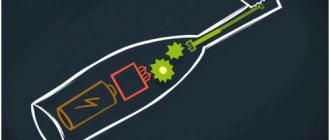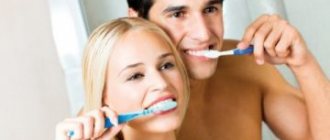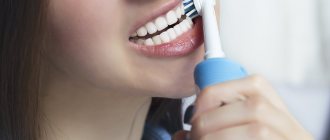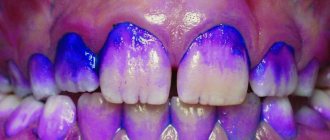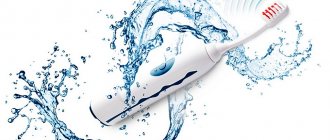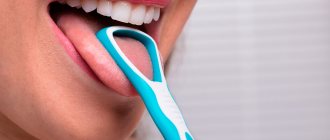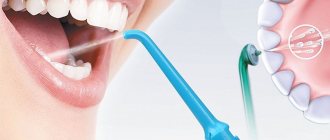- What are dental floss and brush used for?
- How to choose dental floss
- Types of dental floss
- How to floss
- Types of dental brushes
- How to choose a brush
- How to brush your teeth with a brush
- Which brand of dental floss and brushes should I choose?
The tooth has as many as five surfaces, each of which needs regular cleaning. A toothbrush can only clean three sides - the outer, inner and chewing sides. But she cannot reach the interdental spaces, where food debris accumulates and harmful bacteria multiply, which lead to caries. By the way, the total area of such spaces is about 40% of the area of all teeth, and more than half of the cases of caries begin there.
There are several ways to clean the interdental spaces - an irrigator, a brush and dental floss. These are important oral care products and necessary accessories for those who wear braces. You can read more about caring for braces here. We have also already written a lot about irrigators, so in this article we will talk about what brushes and flosses are and how to use them.
What are dental floss and brush used for?
Floss and brush solve a number of problems:
- help remove pieces of food from hard-to-reach places;
- remove soft plaque, preventing the formation of caries, tartar, gingivitis and bad breath.
It would seem that these two items perform the same function, but no.
Each tooth in the mouth does its job. The incisors bite off the food, the fangs tear it into small pieces, the chewing teeth grind it into porridge, so that the food bolus then goes further into the stomach.
Due to the fact that the functions of teeth are different, their shape is also different and the interdental spaces are also different.
The front teeth - incisors and canines - have even spaces. Thread is ideal for cleaning them. We'll talk about the correct cleaning technique below.
The chewing teeth (those located further) have uneven spaces; they may have indentations that are not visible to us. In this case, dental floss will be ineffective because it will only be able to clean the joints of the teeth, but will not reach the grooves.
A thread can't do it, but a brush can. This is because its flexible bristles compress in narrow areas between the teeth, and expand in wide areas. This way no surface will be missed.
Therefore, dental floss is ideal for cleaning the front teeth, and brushes are ideal for cleaning the back teeth.
Types of dental floss
- Made from natural silk - they clean enamel well, but such threads are expensive and fragile, so there is no point in using them.
- Made from nylon, they are as elastic as silk, but are cheaper.
- Acetate is an elastic, durable fiber with a structure similar to silk.
- Made from nylon - they have high strength, but have a rough structure.
- With Teflon coating - they carefully care for teeth, do not injure the gums, and do not separate into fibers. The main feature is that they are flat, like a ribbon and the smoothest. Suitable for the narrowest interdental spaces.
The texture of the thread can be:
- waxed - it is coated with a layer of wax, making it easier to penetrate hard-to-reach places. Suitable for people with a large number of fillings, beginners and children;
- unwaxed - it better removes dietary fiber due to stratification and coverage of most of the tooth.
Thread shapes:
- round;
- flat (tape);
- volumetric (expanding);
- superfloss.
If you just need to clean between your teeth, choose regular floss based on the distance between your teeth. If they are located close to each other, choose tape. If the distance is normal, use a round thread. If it is wide, it is a voluminous floss: under the influence of saliva it swells and fills the entire interdental space. Even if your gaps are of different widths, volume floss will adjust. Also, due to its softness, it is suitable for sensitive gums.
If you are concerned about severe plaque formation, try floss impregnated with chlorhexidine - it has an antibacterial effect. And the thread with zinc and fluoride ions prevents the development of caries.
If you whiten your teeth yourself using pastes or trays, remember that traces of the old tone may remain in the spaces between teeth. In this case, you will need a thread with carbamide peroxide, which saturates the enamel with oxygen and thereby whitens it.
If you have braces, implants, crowns and bridges, your option is superfloss. This is a thread that combines two types of fibers.
- Hard fiber
A rigid tip is made of it, with the help of which the floss easily penetrates narrow spaces in structures, for example, under an arch.
- Sponge fiber
Used to remove plaque from braces, bridges and implants.
Alternating the fibers with each other allows the superfloss to reach places where regular dental floss cannot reach.
Technology using different types of brushes
Improper cleansing is one of the main causes of diseases of dental and periodontal tissue. Even though most people know the general rules for cleaning their mouth, it is not always effective.
First of all, it depends on the type of brush used, since each device requires its own technology.
Regular
This process, using a standard brush, should last at least three minutes . The number of procedures cannot be less than twice a day. The best option is to use the brush after eating.
The process itself consists of several steps:
- wet the brush with water and apply the required amount of paste;
- start the procedure from the upper jaw, visually dividing it into two segments;
- the process should begin with the front incisors, gradually moving towards the molars;
- position the brush in relation to the front surface at an angle of 45°, at the base of the crown;
- Using a sweeping motion, from the gum pocket to the cutting part, we clean the front sides of the tooth;
- when working on the inside, the brush must be directed at a slight angle vertically;
- The cutting surface is cleaned using circular movements. In this case, the brush is positioned perpendicular to the chewing side;
- We process the bottom row in the same way.
- Finally, clean your tongue and rinse your mouth with water or mouthwash.
Next is a training video with visual examples of using a regular toothbrush:
Electrical
An electric brush is an effective means of removing deposits from enamel. It allows cleaning without any effort, since when turned on it makes circular movements at maximum speed.
But when using it, you must remember that such a device can cause harm in case of periodontal diseases, leading to high tooth mobility. Use after surgery in the oral cavity is also contraindicated.
Step-by-step description of the procedure for cleansing the oral cavity with an electric brush:
- moisten the brush under running water and apply the required amount of paste. Do not squeeze out a large amount of paste, as the high speed of the device may cause the formation of excessive foam. This will complicate the cleaning procedure and increase its time;
- Place the device horizontally so that the bristles of the head cover the chewing surface of the crown and turn on the device. Start the procedure from the front incisors, gradually moving towards the back teeth;
- hold the brush in this position for 3 or 4 seconds. Light reciprocating movements of the device along the crown are allowed;
- move the device to a vertical position and process the inside and outside;
- After completely cleaning one tooth, move the brush to another with a smooth movement.
The following video will teach you how to use an electric toothbrush correctly:
Ultrasonic
An ultrasonic brush is a tool that cleans crowns using high-frequency waves. This device allows you to remove pathogenic particles not only on the visible part, but also in the gum pockets at a depth of up to 4 mm .
Detailed usage description:
- Before use, set the required mode. As a rule, brushes of this type have several modes: standard, with or without vibration, and enhanced.
- A small amount of paste is applied to moistened bristles. Typically no larger than the size of a pea is recommended;
- start the process from the farthest molar;
- position the head of the device at an acute angle to the inside of the crown;
- turn on the device and, using circular movements, first clean the gum pocket, and then the entire surface of the crown, gradually moving towards the chewing part;
- The same method is used to remove plaque from the outer part;
- The chewing side is treated with a brush located horizontally. In this case, it is necessary to make movements back and forth on the surface;
- Excessive physical effort should be avoided during the cleansing process. It should take at least 1.5 minutes to treat the dentition of one jaw.
The following video contains recommendations for the correct use of a sonic toothbrush (watch from the 4th minute):
Monobeam
The monobeam brush appeared not so long ago, but has already gained great popularity. With it you can easily clean all hard-to-reach places, including interdental spaces and gum pockets . This made the brush popular among people with orthodontic structures.
The device is very convenient to use, as it is small in size. It can also be used without toothpaste.
To get the proper result, you must carry out the cleansing procedure correctly:
- visually determine the segments of the dentition and the order of cleaning. We start work from any segment convenient for you;
- One of the important nuances when using a mono-beam brush is the correct grip of the handle. Fingers must be placed on power ledges to prevent slipping;
- place the device at an angle (approximately 45°) to the tooth line bordering the gum;
- moving in a semicircle, as if sweeping out a gum pocket;
- after which we clean the internal, external and cutting surfaces in a circular motion;
- During the process, you should not make special efforts so as not to injure the mucous tissue. The procedure for cleaning one tooth lasts about 10 seconds.
Using this device is very simple - watch the video:
We have prepared instructions for Crest Whitestrips teeth whitening strips in a special publication.
We invite you to look at the photo and find out what periodontitis looks like.
Here: https://zubovv.ru/ortodontiya/breketyi/skolko-stoyat-na-zubyi-dlya-korrektsii-prikusa.html - we’ll tell you how much sapphire braces cost.
How to floss
There are several cleaning methods. The standard technique is available in many available sources, but it has a significant drawback: if you do not control the sliding of the floss between the teeth, you can seriously injure the gums. In addition, the thread needs to be wound around the index and middle fingers, and this is not very convenient, and it’s just painful.
An alternative is the loop method. This is a simple technique that does not use force, which means the risk of gum damage is minimal. You control the dental floss, and in this position it is convenient to hold it with your fingers.
1. Measure 20-30 cm of thread. To measure the distance, you need to wrap the thread around your fingers, as shown in the figure. If the loop turns out to be large, the thread will be inconvenient to use.
2. Connect the two ends and tie them so that you get a loop that will fit 4 fingers of your right hand and 4 fingers of your left hand at the same time. If you have waxed thread, the knot may come undone, in which case make it a double knot.
3. Place the fingers of both hands in the center of the loop, leaving your thumbs outside the loop. Using your little fingers, create a stop at the bottom of the loop. This will allow you to control the sliding of the thread along the tooth wall.
4. Place the floss between your thumbs so that the distance between them is no more than 5 mm. This will allow you to control the movement of the thread in the interdental space.
5. Move the floss gently up and down along the side of the tooth, starting from the gum.
6. Without removing the floss from the interdental space, transfer it to the adjacent tooth and clean its side surface.
7. Remove the floss from the interdental space. Move your fingers slightly in the loop onto a clean section of thread. Repeat the procedure with the next interdental space.
This technique will allow you to brush your teeth not only effectively, but also safely for your gums. Ideally, you should floss your teeth after every meal, that is, about 3 times a day.
Let us remind you once again that plaque can be effectively removed with floss only between the front teeth. When cleaning the spaces between chewing teeth, floss will do a worse job than a brush.
Rules for using floss
Waxed dental floss glides easier between teeth, has a denser structure, and is less susceptible to delamination. Such threads are very elastic, so when used, the risk of damaging the delicate gum tissue is lower. They are suitable for beginners. Floss is not a replacement for a toothbrush! It should be used after meals, as well as before morning and evening brushing of teeth.
Due to the splitting of the fibers, unwaxed dental floss adheres more firmly to the surface and cleans teeth better. The right thing to do is to floss over each tooth until a characteristic squeak appears. The technique should first be practiced on waxed dental floss.
Fedorova Yana Valentinovna
Dentist-therapist-periodontist, AktivStom clinic
If you select and use dental floss incorrectly, you can injure the gingival papilla, which will lead to bleeding and pain. In this case, the procedure must be suspended for 2-3 days. It is recommended to apply Metrogyl Denta ointment or Asept adhesive gum balm to the damaged area.
How to choose a brush
At first glance, all dental brushes seem the same - small brushes with multi-colored handles. But each of us has different spaces between our teeth, which means it is important to choose your brush size. This is important because if the brush is smaller than your interdental space, it will not be able to completely remove plaque. If it is larger, it may injure the gums, or, most likely, will not pass into the gap.
It is impossible to understand right away how long the bristles you need in a brush. First you will need to take measurements. Today this is possible at home, using a special probe.
The most convenient probe for such purposes is the Curaprox IAP prime probe. This is a small stick that is divided into 5 color zones. Each zone corresponds to the size and length of the brush head and corresponds to the color of the handle of a particular brush from the Curaprox Prime line. The probe can be purchased separately or in a set with several brushes.
The entire measurement procedure will take a few seconds and guarantees 100% accuracy in the selection of hygiene products based on your individual parameters. Usually, brushes are not used between the incisors (remember, there are threads for this), so after purchasing a probe, measure each distance between the chewing teeth. In one place the interdental distance will be greater, in another less. Based on this measurement, mark the sizes of brushes you need.
If you are just going to start using brushes, it is worth purchasing a starter set with different sizes. This, again, is available from Curaprox.
Clinical researches
Clinical studies have proven that regular use of professional toothpaste ASEPTA REMINERALIZATION improved the condition of the enamel by 64% and reduced tooth sensitivity by 66% after just 4 weeks.
Sources:
- Report on the determination/confirmation of the preventive properties of personal oral hygiene products “ASEPTA PLUS” Remineralization doctor-researcher A.A. Leontyev, head Department of Preventive Dentistry, Doctor of Medical Sciences, Professor S.B. Ulitovsky First St. Petersburg State Medical University named after. acad. I.P. Pavlova, Department of Preventive Dentistry
- Evaluation of the clinical effectiveness of a combined drug of local etiotropic action in the treatment of inflammatory periodontal diseases (E.L. Kalichkina, E.A. Tyo, Z.Z. Abubakarova) E.L. Kalichkina, candidate of medical sciences, assistant of the department of therapeutic dentistry, Kemerovo State Medical Academy of Roszdrav, Kemerovo E.A. Tyo, MD, professor, head of the department of therapeutic dentistry, Kemerovo State Medical Academy of Roszdrav, Kemerovo Abubakarova, assistant of the department of therapeutic dentistry, Kemerovo State Medical Academy of Roszdrav, Kemerovo GOU HPE Kemerovo State Medical Academy of Roszdrav , Kemerovo
- Clinical and laboratory assessment of the influence of domestic therapeutic and prophylactic toothpaste based on plant extracts on the condition of the oral cavity in patients with simple marginal gingivitis. Doctor of Medical Sciences, Professor Elovikova T.M.1, Candidate of Chemical Sciences, Associate Professor Ermishina E.Yu. 2, Doctor of Technical Sciences Associate Professor Belokonova N.A. 2 Department of Therapeutic Dentistry USMU1, Department of General Chemistry USMU2
Types of dental brushes
You need to choose brushes based on the shape and length of the bristles. There are two types of brush shapes: cylinder and cone.
- Cylinder
It has the same length of bristles, copes well with food stuck between teeth, prevents periodontitis, and is suitable for implants.
- Cone
The bristles become shorter towards the tip of the brush. Suitable for cleaning braces and dentures, as it allows you to clean areas under the clasps and in the spaces between the crowns.
What length of bristles is needed depends on the size of the spaces between the teeth. If they are narrow, brushes with short bristles (about 1 mm) are suitable. If, on the contrary, you are large or have braces, choose a brush with bristles no shorter than 3 mm.
Recommendations
Brushing teeth with braces
Before starting the procedure, you should wash your hands with soap. If it is difficult to pass the thread between the teeth, you need to purchase a coated model, which will greatly facilitate the passage of the thread between the teeth.
If you have braces, it is important to consult your dentist about the best cleaning method. The doctor will recommend special holder devices. Those who experience some discomfort should also seek professional advice from a dentist.
There is no consensus on when you should floss before or after brushing, but experts are unanimous that this should be done daily and especially before going to bed.
How to brush your teeth with a brush
The best time to clean between teeth is in the evening. Whether you do this before or after brushing your teeth doesn’t matter.
We consider Curaprox interdental brushes to be one of the best. They are very easy to use, and their manufacturer has proposed their own cleaning method - just like in the case of atraumatic flossing using the loop method.
1. Insert the brush at an angle to the gum.
2. Turn the brush perpendicular to the teeth and carefully move it into the interdental space.
3. You should feel that the brush has come out from the other side.
4. 1 gap = 1 movement of the brush. Do not rotate the brush or move it back and forth.
5. Slowly remove the brush and insert it into the next gap.
Technology using an irrigator
Not long ago, an irrigator was introduced into use. This device is capable of cleaning all hard-to-reach areas using pressurized water without causing harm to dental and periodontal tissue .
In addition, this design involves the use of not only water, but also medicinal products.
The irrigator, like other devices, requires proper use:
- lean over the sink, set the required liquid flow rate and turn on the device;
- start with the furthest molars. Point the irrigator head at the space between them at a right angle and apply liquid;
- after this, transfer the stream to the gum pocket, washing away plaque from there and performing an additional massage;
- Finally, treat the rest of the tooth;
- walk in the same way along the entire row of teeth in both jaws. The entire procedure should take at least 5 minutes, but no more than 15.
Below is a short video on the correct use of the irrigator:
Find out how long an adult should wear braces to correct their bite.
This article names only the best medications for toothache.
Here: https://zubovv.ru/krasota-i-uxod/zubnyie-shhetki/elektricheskie-oral-b-professionalnaya-zabota-v-domashnih-usloviyah.html - the Oral Bee Triumph 5000 electric toothbrush is described.
Which brand of dental floss and brushes should I choose?
Dental floss and brushes must be durable, not oxidize under the influence of saliva and not cause allergies. We recommend products from Curaprox, Biorepair, Miradent, Pierrot, GUM, ROCS and Splat - all of them meet these requirements.
When making a purchase, you should focus not on the manufacturer, but on the type of dental floss or brush, taking into account the individual characteristics of the structure of the teeth, the presence of orthodontic structures and your dental goals. However, some brands have distinctive features that should be taken into account.
Thus, Prime Start brushes from Curaprox are considered the thinnest on the market. The Cural surgical steel from which the rods are made does not contain nickel and is therefore ideal for allergy sufferers. And the bristles of Biorepair brushes are treated with tiny particles of hydroxyapatite - the building substance that our teeth are made of. By acting on the enamel, microRepair particles restore and strengthen it.
Teaching correct methods to children
Cleaning children's teeth often causes a lot of problems. Before starting this activity, the child needs to be interested or motivated . As a rule, imagining the cleaning process in the form of a game gives a good effect.
But even if the child is happy to do this procedure, it is worth monitoring the correct execution of all actions. How should children brush their teeth?
This question can only be answered by conditionally dividing them into two groups:
- Children under one year old .
This category of children, just like adults, needs to clean their emerging teeth. Already from the appearance of the first teeth, it is worthwhile to regularly clean them. To do this, after each feeding, wipe the surface of the teeth with a clean napkin or cotton pad moistened with boiled water. - Children after one year .
For this category, this procedure does not differ from the standard process of brushing teeth for adults. The only difference is the paste and brush used: up to three years, the brush must be soft and not cover more than two crowns, and the paste cannot contain fluoride. After this age, when using such products, you must adhere to the dentist’s recommendations.
The entire cleansing process should be carried out under the supervision of an adult and not exceed 3 minutes, since the enamel in children is too weak.
Proper brushing of teeth is considered an insignificant process. But practice shows that compliance with the necessary technique is an important factor in preventing dental diseases.
Well, the following video will help teach your child how to brush their teeth correctly:
If you find an error, please select a piece of text and press Ctrl+Enter.
Tags braces video dental floss toothbrushes irrigators monobeam toothbrushes ultrasonic toothbrushes teeth cleaning electric toothbrushes
Did you like the article? stay tuned

